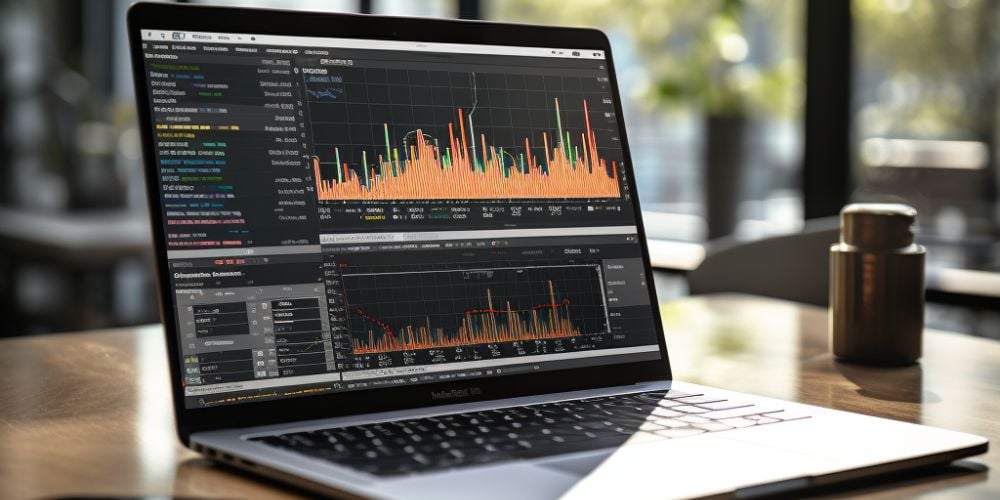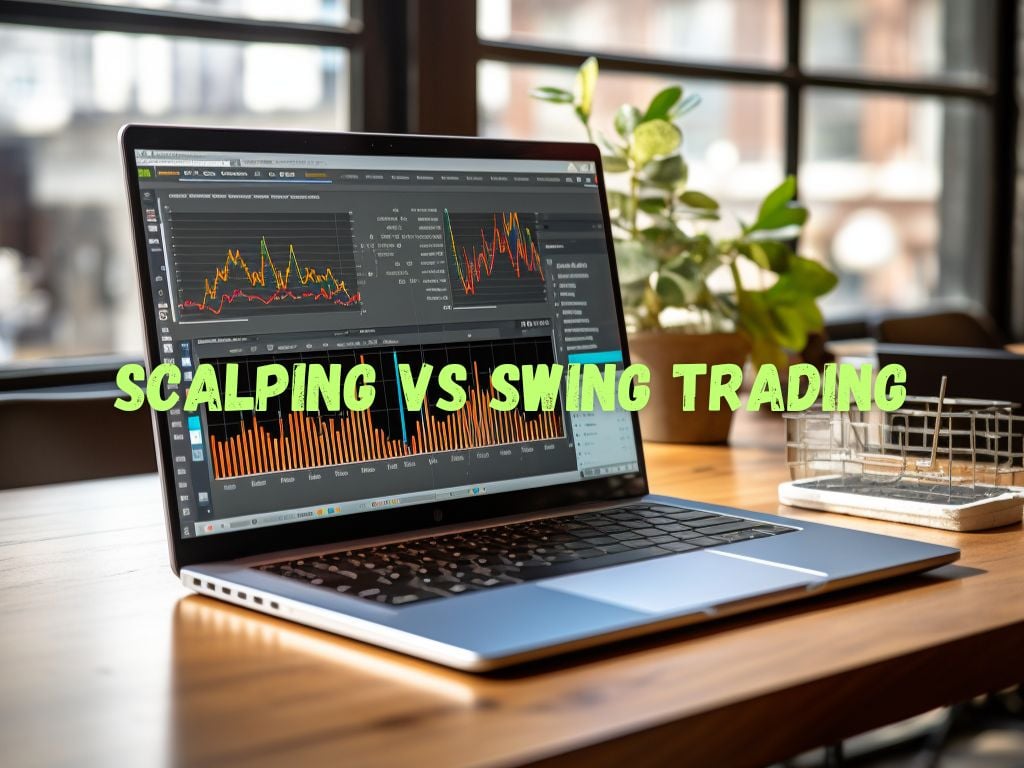When it comes to trading in the financial markets, there are a variety of approaches that have proved to be successful.
Two popular trading strategies are scalping and swing trading, each with their own distinct characteristics and advantages.
That’s why it becomes important to address this scalping vs swing trading debate once and for all.
In this article, we will explore scalping and swing trading in detail, highlighting the key differences and delving into which strategy may be best suited for your trading style.
What Is Scalping?
Scalping is a popular trading strategy that focuses on quick trades, typically lasting only seconds or minutes.
The goal of scalping is to profit from small price movements in the market, by buying low and selling high, or vice versa. Scalping requires quick reflexes, laser focus, and discipline to stick to a trading plan.

Advantages of Scalping
There are several advantages to using scalping as a trading strategy. One of the most significant is the potential for high returns.
Because scalping involves taking advantage of small price movements, traders can make multiple trades in a short amount of time, resulting in a higher overall profit potential.
Scalping also allows traders to maximize their trading opportunities, taking advantage of multiple trades throughout the day.
Pitfalls to Avoid in Scalping
While scalping can be a profitable trading strategy, there are several pitfalls that traders need to avoid in order to succeed.
One of the biggest challenges for scalpers is market volatility. Because scalpers are looking to make quick trades, they can be vulnerable to sudden price swings that can wipe out their profits.
Scalpers must therefore operate with caution, being ready to exit a trade if the market turns against them.
Best Practices for Successful Scalping
To be a successful scalper, there are several best practices that traders should follow.
One of the most important is to choose the right trading platform. Scalping requires a trading platform that is fast, reliable, and equipped with advanced charting and technical analysis tools.
Other best practices include setting strict stop-loss orders to limit potential losses, using a consistent trading plan, and focusing on liquid markets with low transaction costs.
What is Swing Trading?
Swing trading is a trading strategy that focuses on profiting from market trends, typically lasting several days or even weeks.
The goal of swing trading is to identify market trends and ride them for profit, by buying at the bottom of a trend and selling at the top, or vice versa.
Swing traders need patience, discipline, and a solid understanding of market dynamics to consistently make profitable trades.
Advantages of Swing Trading
There are several advantages to using swing trading as a trading strategy. One of the most significant is the reduced stress and pressure that comes with taking longer-term trades.
Swing traders can take their time to identify market trends and make trades accordingly, without the need for quick reflexes or split-second decision making. This can result in more consistent profits and lower stress levels.
Challenges of Swing Trading
While swing trading can be a profitable trading strategy, there are also some challenges that traders need to be aware of.
One of the biggest challenges is the potential for market volatility. Swing traders need to be able to identify when a trend is about to change, in order to exit a trade and avoid heavy losses.
This requires careful monitoring of market trends and developing a solid understanding of market dynamics.
Best Practices for Successful Swing Trading
To be a successful swing trader, there are several best practices that traders should follow.
One of the most important is to identify market trends and ride them for profit. Swing traders must also have a solid understanding of technical analysis and charting to be able to identify potential trends.
Other best practices include setting strict stop-loss orders, focusing on liquid markets, and maintaining a consistent portfolio of stocks.

Scalping vs Swing Trading: Exploring Contrasting Trading Strategies
Now that we’ve explored both scalping and swing trading in detail, let’s compare and contrast the two strategies in order to help you identify which one may be right for you.
Timeframe and Trading Style
Swing Trading
- Timeframe: Utilizes longer time frames such as daily or weekly charts to identify trends.
- Trading Style: Typically, swing traders are more patient and have longer holding periods.
Scalping
- Timeframe: Focuses on shorter time frames such as one-minute or five-minute charts to identify short-term price movements.
- Trading Style: Scalpers need to make quick decisions and execute trades swiftly. They have a more active and fast-paced trading style.
Risk and Reward
Swing Trading
- Risk: Swing traders generally expose themselves to higher risks compared to scalpers as they hold positions for a longer time. They are susceptible to bigger price fluctuations and overnight market risks.
- Reward: Swing traders aim for larger profit targets as they capture trends that extend over multiple days or weeks.
Scalping
- Risk: Scalpers’ risk exposure is relatively lower as they trade in the short term and rarely hold positions overnight. However, they might be more susceptible to transaction costs due to frequent trades.
- Reward: Scalpers target smaller but more frequent and immediate profits from multiple trades.
Market Conditions and Volatility
Swing Trading
- Market Conditions: Swing trading works better in trending markets with prolonged price moves. It may struggle during periods of consolidation or choppy markets.
- Volatility: Swing traders can take advantage of moderate to high volatility, making it important for the underlying asset to have enough price fluctuations.
Scalping
- Market Conditions: Scalping is well-suited for markets with high liquidity and frequent price movements. It may face challenges in markets with low liquidity or during news events when spreads widen.
- Volatility: Scalpers can work in various volatility conditions but may prefer higher volatility to benefit from more significant price changes.
Trading Capital and Resources
Swing Trading
- Trading Capital: Typically, swing traders require a larger capital base to withstand potential drawdowns and overnight risks.
- Resources: They may need access to fundamental and technical analysis tools to identify longer-term trends and potential entry/exit points.
Scalping
- Trading Capital: Scalpers can start with smaller trading accounts due to the smaller profit targets per trade. However, they need to consider transaction costs from frequent trading.
- Resources: Scalpers rely heavily on real-time data feeds, quick execution platforms, and access to Level II market depth for effective decision-making.
Psychological Demands
Swing Trading
- Psychological Demands: Swing trading requires patience and discipline to hold positions during periods of market noise or temporary price reversals.
- Emotions: Swing traders need to manage emotions associated with holding positions for extended periods and withstand potential market volatility.
Scalping
- Psychological Demands: Scalping demands a high level of focus, concentration, and discipline to execute rapid trades and make quick decisions.
- Emotions: Scalpers need to avoid impulsive behavior and handling the pressure associated with making split-second trading choices.
It’s important to note that the effectiveness of these strategies may vary for each individual, and traders should consider their own skills, preferences, and risk tolerance when choosing a trading style.

Frequently Asked Questions
Q: Which is better – scalping or swing trading?
A: Neither is inherently “better” than the other – it all depends on your trading style and risk tolerance.
Q: Is scalping more profitable than swing trading?
A: Scalping has the potential for higher returns, but also higher risk. Swing trading is generally seen as a more consistent strategy, with lower risk, but potentially lower returns.
Q: Which markets are best for scalping?
A: Scalping is best suited for high-liquidity markets, such as the forex market or futures markets. These markets generally have low transaction costs and tight bid-ask spreads.
Q: What are the primary risks associated with swing trading?
A: The primary risk associated with swing trading is market volatility. Swing traders need to be able to identify when a trend is about to change, in order to exit a trade and avoid heavy losses.
Conclusion
In summary, scalping and swing trading are two popular trading strategies, each with their own distinct characteristics and advantages.
While neither is inherently “better” than the other, it all comes down to your trading style and risk tolerance.
If you’re someone who is comfortable with high-risk trades and a fast-paced trading style, then scalping may be the right strategy for you.
If you’re someone who is more risk-averse and has a longer-term investment mindset, then swing trading may be the right strategy for you.
Remember, the key to success with either strategy is discipline, patience, and a solid understanding of market dynamics.
By following best practices, avoiding common pitfalls, and staying focused on your goals, you can develop a profitable and sustainable trading strategy that works for you.


 Tags:
Tags:










